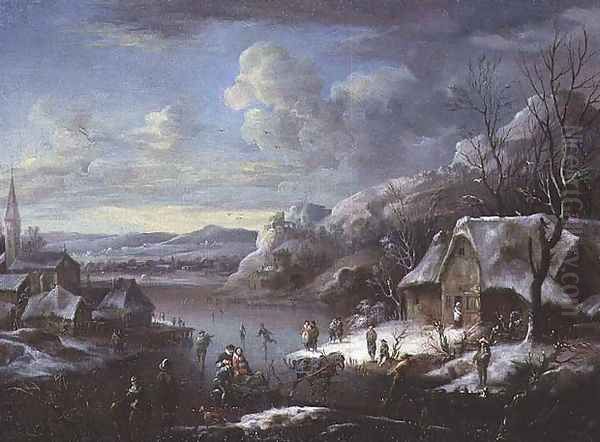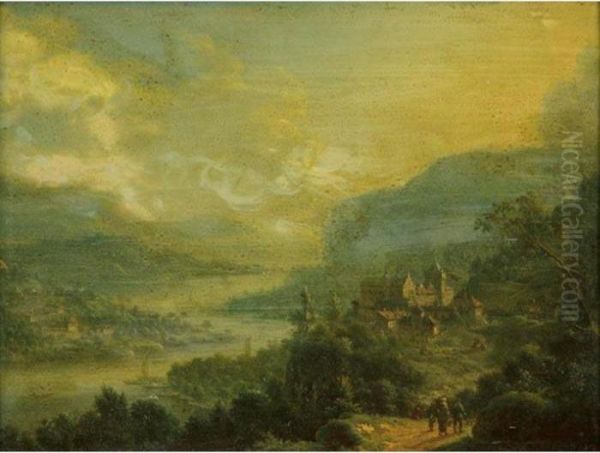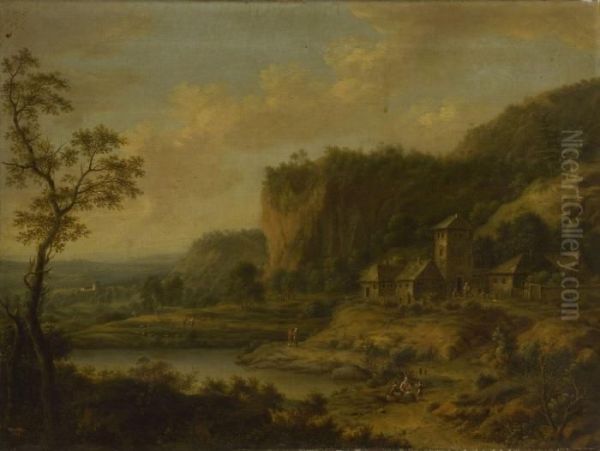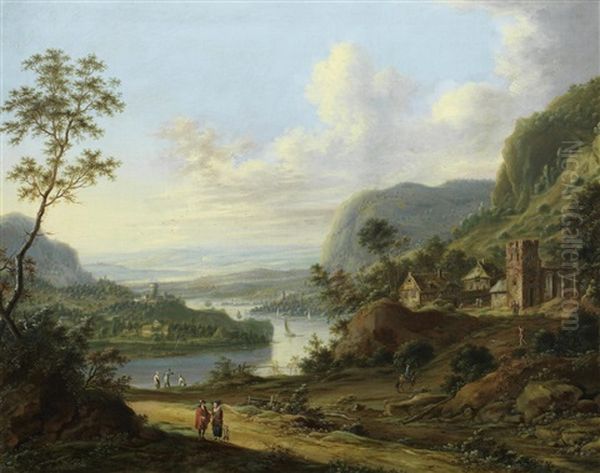Introduction: An Overview of the Artist
Johann Christian Vollerdt stands as a notable figure in the landscape of 18th-century German art. Born in 1708 and passing away in 1769, Vollerdt dedicated his artistic career primarily to landscape painting. He developed a distinct style characterized by meticulous detail, atmospheric sensitivity, and a clear affinity for the traditions of Dutch Golden Age masters. Working predominantly in oil, his canvases often depict serene rural vistas, dramatic weather phenomena, and charming winter scenes, populated by small figures that add life and scale to the natural world. His work found considerable favour during his lifetime and continues to be appreciated for its technical skill and evocative power.
Early Life and Artistic Beginnings
Johann Christian Vollerdt entered the world in Leipzig, a significant cultural and commercial hub in Saxony, in 1708. While specific details about his earliest training remain somewhat scarce, it is highly probable that he underwent a traditional apprenticeship, learning the fundamentals of drawing and painting from a local master. Leipzig, with its university and publishing houses, offered a stimulating environment, though Dresden would soon become the primary center for the arts in Saxony. Vollerdt's formative years would have exposed him to the prevailing artistic currents, including the lingering influence of the Baroque and the emerging Rococo style, alongside the enduring appreciation for Dutch art that was common among German collectors and artists. His career began in Leipzig before he made the pivotal move to Dresden, the city where his artistic identity would fully mature.
Dresden: A Flourishing Artistic Center

Vollerdt's decision to relocate to Dresden placed him at the heart of one of Europe's most vibrant artistic capitals during the 18th century. Under the Electors of Saxony, particularly Augustus II the Strong and his son Augustus III, Dresden was transformed into a "Florence on the Elbe." The city boasted magnificent Baroque architecture, lavish court festivities, and, crucially for artists, significant patronage and world-class art collections, most notably the Gemäldegalerie (Picture Gallery). This environment provided artists like Vollerdt with unparalleled opportunities to study masterpieces, particularly the rich holdings of Dutch and Flemish paintings, and to potentially secure commissions from the court or the aristocracy. Vollerdt established himself within this dynamic milieu, developing his practice and reputation as a skilled landscape specialist.
Artistic Style: Dutch Heritage and Rococo Sensibility
The most defining characteristic of Johann Christian Vollerdt's art is its deep connection to the Dutch landscape tradition of the 17th century. He clearly studied and absorbed the lessons of masters such as Jacob van Ruisdael, Meindert Hobbema, and particularly Herman Saftleven, whose detailed river views and atmospheric perspective find echoes in Vollerdt's work. The influence of Jan Griffier the Elder, a Dutch painter known for his river landscapes and winter scenes, often featuring numerous small figures, is also explicitly noted by art historians and was likely a significant source of inspiration for Vollerdt's compositions and subject matter. This Dutch influence is evident in his careful rendering of textures, his nuanced depiction of light and atmosphere, and his choice of subjects like frozen canals and wooded valleys.
However, Vollerdt was not merely an imitator. He adapted these influences to the tastes of his own time, infusing his work with elements of the prevailing Rococo sensibility. This might be seen in the slightly brighter palettes sometimes employed, the picturesque arrangement of compositional elements, and a general emphasis on the charm and pleasantness of nature, even when depicting potentially dramatic scenes like thunderstorms. His brushwork is often delicate and precise, allowing for a high degree of detail, particularly in the rendering of foliage, architecture, and the small figures that populate his scenes. Some sources mention a "concise and calligraphic aesthetic," perhaps referring to this clarity of detail and compositional structure within his often modestly scaled cabinet pictures.
Subject Matter: Capturing Nature's Theatre
Vollerdt's oeuvre revolves around the landscape, explored through various recurring themes and motifs. He excelled in depicting expansive river valleys, often flanked by rolling hills or distant mountains, providing a sense of depth and tranquility. These scenes are frequently punctuated by architectural elements – castles perched on hilltops, rustic watermills, charming villages – which add points of interest and anchor the composition. He often used trees or rock formations as framing devices, guiding the viewer's eye into the scene, a technique borrowed from his Dutch predecessors.

A particular specialty for Vollerdt was the winter landscape. He is sometimes noted as being one of the few painters in Saxony at the time to focus significantly on these small-scale winter scenes. His depictions often feature frozen rivers or canals bustling with skaters and townspeople enjoying the cold, snow-laden trees, and villages nestled under a blanket of white. These works capture the specific light and atmosphere of winter with remarkable sensitivity.
Beyond seasonal depictions, Vollerdt was fascinated by atmospheric effects and weather phenomena. He skillfully rendered the dramatic light of thunderstorms, the ethereal glow of moonlight on water, and the fleeting beauty of rainbows arching across the sky. These elements add a layer of narrative and emotional resonance to his landscapes, showcasing nature not just as a static backdrop but as a dynamic and ever-changing force.
Integral to his landscapes are the small figures, known as staffage. These figures – typically travelers, peasants, fishermen, or skaters – are never the main subject but serve crucial roles. They animate the scene, provide a sense of scale, and often subtly guide the narrative or mood of the painting. Their careful integration demonstrates Vollerdt's skill in harmonizing human activity with the natural environment.
Occasionally, Vollerdt also turned his hand to Italianate landscapes, painting idealized scenes reminiscent of the Roman Campagna, sometimes featuring classical ruins. This reflects a broader European trend where artists catered to the taste for Arcadian visions inspired by Italy, often influenced by painters like Claude Lorrain or Dutch Italianate artists such as Jan Both.
Analysis of Representative Works
Several paintings exemplify Johann Christian Vollerdt's artistic concerns and skills. His Winter Scene with Numerous Figures, also known under titles like Winter landscape with figures skating on a river, a windmill beyond, is perhaps one of his most characteristic works. It showcases his mastery of the winter theme, with finely detailed figures engaged in various activities on the ice, set against a backdrop of snow-covered landscape and architecture. The anecdote connecting a version of this theme to a commission from the Dutch diplomat Cornelis Calkoen (who served in Dresden 1746-1749) highlights the appeal of Vollerdt's Dutch-inspired scenes to patrons familiar with that tradition.
Another documented work, An Italianate landscape with a temple ruin and fishermen in the background, dated 1752, demonstrates his engagement with the popular Italianate genre. Measuring a modest 40.5 x 35 cm, this painting likely presents an idealized view, combining picturesque ruins with serene natural elements and small figures, evoking a sense of classical nostalgia popular during the period.

Paintings titled Travelers In An Extensive River Landscape With Castle or similar variations, such as Gewundene Flusslandschaft mit Mühle und Burg (Winding River Landscape with Mill and Castle), highlight his skill in creating panoramic vistas. These works typically feature winding rivers leading the eye through the landscape, past carefully rendered details like mills or castles, with travelers on foot or horseback adding narrative interest. The composition often emphasizes the breadth and depth of the natural world.
Works simply titled Landschaft mit Figurenstaffage (Landscape with Figure Staffage) further underscore the importance of the interplay between landscape and human presence in his art. These paintings, regardless of specific setting, consistently display his meticulous technique and his ability to create balanced, harmonious compositions that capture the essence of the German countryside or idealized natural settings.
Vollerdt in Context: Contemporaries and Influences
To fully appreciate Vollerdt's contribution, it is helpful to place him within the context of his contemporaries and the broader artistic landscape. In Dresden, his most significant contemporary in landscape painting was arguably Christian Wilhelm Ernst Dietrich (often known as Dietricy, 1712-1774). Dietricy was incredibly versatile, working in various genres and mastering the styles of numerous earlier masters, including Dutch landscape painters. While perhaps more eclectic than Vollerdt, Dietricy shared a similar grounding in Dutch traditions. Another important figure in Dresden landscape painting was Johann Alexander Thiele (1685-1752), slightly older than Vollerdt, known for his topographical views of Saxony, who likely exerted some influence on the younger artist. While primarily a portraitist, Anton Graff (1736-1813) was also a major figure in the Dresden art scene during the later part of Vollerdt's life.
Beyond Dresden, the Swiss poet and painter Salomon Gessner (1730-1788) was gaining renown for his idyllic landscapes, contributing to the growing appreciation for nature in art across German-speaking lands. Vollerdt's Dutch influences, as mentioned, were paramount, connecting him to a lineage including Herman Saftleven, Jan Griffier, Jacob van Ruisdael, Meindert Hobbema, Aelbert Cuyp, and Jan van Goyen. It is important to note that some artists occasionally mentioned in connection with Vollerdt, such as Gerrit Battem (c. 1636-1684) and Abraham Furnerius (c. 1628-1654), were significant 17th-century Dutch landscape painters whose work Vollerdt might have known, but they were not his contemporaries. Charles van Falens (1683-1733), a Flemish painter active in Paris known for hunting scenes in the manner of Philips Wouwerman, represents an older generation working within related Northern European traditions.

Looking wider, Vollerdt worked during a period when landscape painting was evolving across Europe. In France, the idealized classical landscapes of Claude Lorrain and Nicolas Poussin remained influential, while artists like Joseph Vernet were gaining fame for their seascapes and topographical views. In Venice, view painters like Canaletto and Francesco Guardi captured the city's unique atmosphere, which resonated with the taste for detailed depictions of specific locales, even influencing views of cities like Dresden. In Britain, Richard Wilson was pioneering a classical landscape style influenced by his time in Italy, running parallel to Vollerdt's own engagement with Italianate themes. Vollerdt's work sits comfortably within this 18th-century European context, representing a distinctly German interpretation of landscape painting, deeply rooted in Dutch traditions yet responsive to contemporary Rococo aesthetics.
Legacy, Collections, and Reputation
Johann Christian Vollerdt enjoyed considerable success during his lifetime. His finely crafted landscapes appealed to the tastes of the Saxon court, the aristocracy, and the growing bourgeois collector base. His ability to evoke specific moods and atmospheres, combined with his technical proficiency, ensured a steady demand for his work. His paintings were disseminated relatively widely, entering private collections across Germany and beyond.
Today, Vollerdt's works are represented in major public collections, confirming his historical significance. The Gemäldegalerie Alte Meister in Dresden holds examples of his paintings, fittingly, given his long association with the city. His works can also be found in other German museums, such as those in Kassel, and likely in various other European institutions, although comprehensive cataloguing can sometimes be challenging for artists of his era.
His paintings continue to appear on the art market, attesting to ongoing collector interest. Provenance records sometimes link his works back to significant historical collections, such as the mention of a painting originating from the collection of the Dutch noble Calkoen family, offered by Sotheby's. Recent auction activity, such as the inclusion of his work in events like the "Auctionen Herbst 2024" held by Kieselstein-Cord in Berlin (November 7-14, 2024), demonstrates that his art remains valued by collectors today. Vollerdt's legacy lies in his contribution to the German landscape tradition, skillfully blending meticulous Dutch realism with the lighter sensibilities of the Rococo, and leaving behind a body of work celebrated for its atmospheric charm and detailed execution.
Conclusion
Johann Christian Vollerdt navigated the rich artistic environment of 18th-century Saxony to carve out a niche as a respected master of landscape painting. From his beginnings in Leipzig to his mature career in the vibrant art center of Dresden, he honed a style deeply indebted to the Dutch Golden Age masters yet distinctly his own. His meticulous renderings of rural scenery, his particular fondness for evocative winter landscapes, and his skillful capture of atmospheric effects secured his reputation during his lifetime and ensure his continued recognition. Through works like his detailed winter scenes and expansive river valleys, Vollerdt invites viewers into a world both carefully observed and artfully composed, representing a significant strand in the tapestry of German Rococo art. He passed away in Dresden in 1769, leaving behind a legacy of charming and accomplished landscapes.